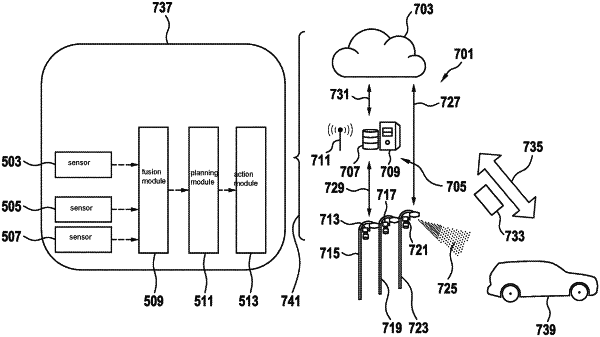| CPC B60W 60/0011 (2020.02) [B60W 30/08 (2013.01); H04W 4/44 (2018.02); B60W 2552/00 (2020.02)] | 9 Claims |

|
1. A method for safely ascertaining infrastructure data for driving a motor vehicle in at least partially automated manner, the method comprising:
receiving data signals, which represent: (i) infrastructure sensor data generated by a plurality of infrastructure sensors, and (ii) motor vehicle data generated by at least one source motor vehicle;
receiving safety condition signals, which represent at least one safety condition for safely ascertaining infrastructure data based on the infrastructure sensor data and the motor vehicle data;
checking whether the at least one safety condition is fulfilled;
ascertaining infrastructure data, based on which a destination motor vehicle is drivable in at least a partially automated manner, based on the infrastructure sensor data and the motor vehicle data, as a function of a result of the check as to whether the at least one safety condition is fulfilled;
generating infrastructure data signals, which represent the ascertained infrastructure data; and
outputting the generated infrastructure data signals;
wherein the motor vehicle data includes route data, an environment model of surroundings of the source motor vehicle, and at least two types of data selected from the following group of motor vehicle data: (b) weather data, which represent a weather in a surroundings of the source motor vehicle, (c) traffic data, which represent a traffic in a surroundings of the source motor vehicle, (d) hazard data, which represent a location of a hazard area and/or a type of the hazard area in the surroundings of the source motor vehicle, and (e) road user state data, which represent a state of a road user in the surroundings of the source motor vehicle,
wherein the plurality of infrastructure sensors provide the infrastructure data to a fusion module, which is configured fuse the infrastructure sensor data, so that the infrastructure sensor data of the plurality of infrastructure sensors are fused in the fusion module,
wherein based on the fused infrastructure sensor data, the fusion module ascertains the environment model of the surroundings of the motor vehicle, which travels on the road, along which the plurality of infrastructure sensors are situated,
wherein the environment model and the fused infrastructure sensor data are provided to a planning module, which is configured to prepare a drive plan for the motor vehicle based on the environment model and/or the fused infrastructure sensor data, so that the planning module plans driving maneuvers, which the motor vehicle is to execute in at least the partially automated manner,
wherein the planned driving maneuver is provided to an action module, which is configured to ascertain traffic system control commands for controlling a lateral and/or longitudinal guidance of the motor vehicle based on the planned driving maneuver so that when the lateral and/or longitudinal guidance of the motor vehicle is controlled based on the control commands, the motor vehicle performs or drives the planned driving maneuver in the at least partially automated manner, and wherein the action module is configured to output the traffic system control commands for controlling one or multiple traffic systems,
wherein the traffic systems include at least one of the following: a light signal system, a barrier, and/or a variable message sign, and wherein the traffic system control commands are generated based on the motor vehicle data the infrastructure sensor data, and a drive specification, which the destination motor vehicle is to follow by driving in at least a partially automated manner,
wherein the motor vehicle data includes motor vehicle data, including diagnostic data, and
wherein the at least one safety condition includes an existence of a predefined safety integrity level or automotive safety integrity level of at least the source motor vehicle and the infrastructure, a communication link and/or communication components with respect to overall systems in the source motor vehicle and infrastructure, and wherein the at least one safety condition includes an existence of a maximum latency of a communication between the source motor vehicle and the infrastructure, and at least one element selected from the following group of safety conditions:
(i) existence of a confirmation of the source motor vehicle that the motor vehicle data are safe,
(iii) existence of a predetermined computer protection level of a device for performing the steps of the method,
(iv) existence of predetermined components and/or algorithms and/or communication options that are used for performing the steps of the method,
(vi) existence of predetermined availability information, which indicates an availability of predetermined components and/or algorithms and/or communication options,
(vii) existence of a plan which includes measures for reducing errors and/or measures in the event of failures of predetermined components and/or algorithms and/or communication options and/or measures for fault analyses and/or measures in the event of misinterpretations,
(viii) existence of one or multiple fallback scenarios,
(ix) existence of a predetermined function,
(x) existence of a predetermined traffic situation,
(xi) existence of a predetermined weather,
(xii) a maximally possible time for a respective implementation and/or execution of a step or of multiple steps of the method,
(xiii) existence of a result of a check to determine that elements and/or functions, which are used for carrying out the method, currently function in a faultless manner.
|